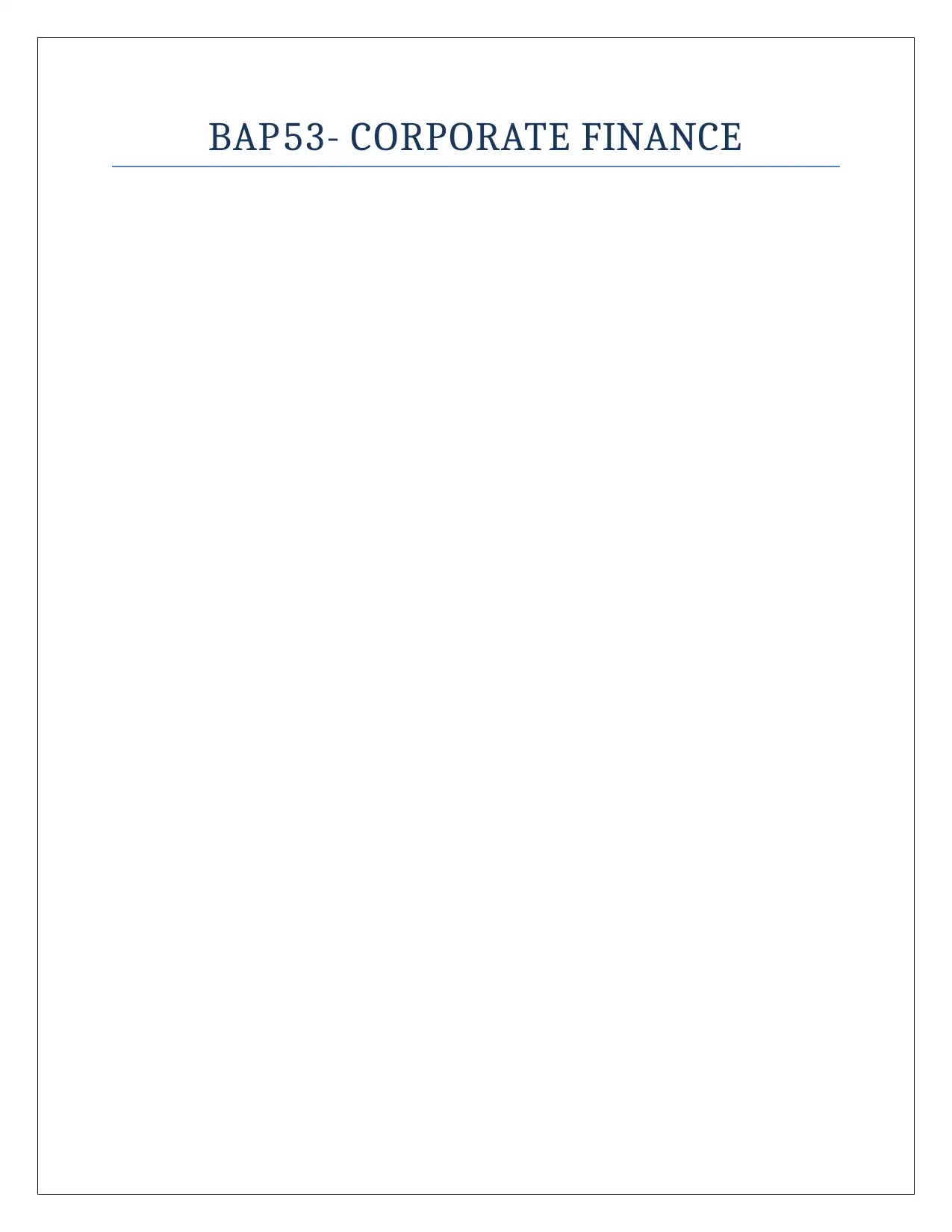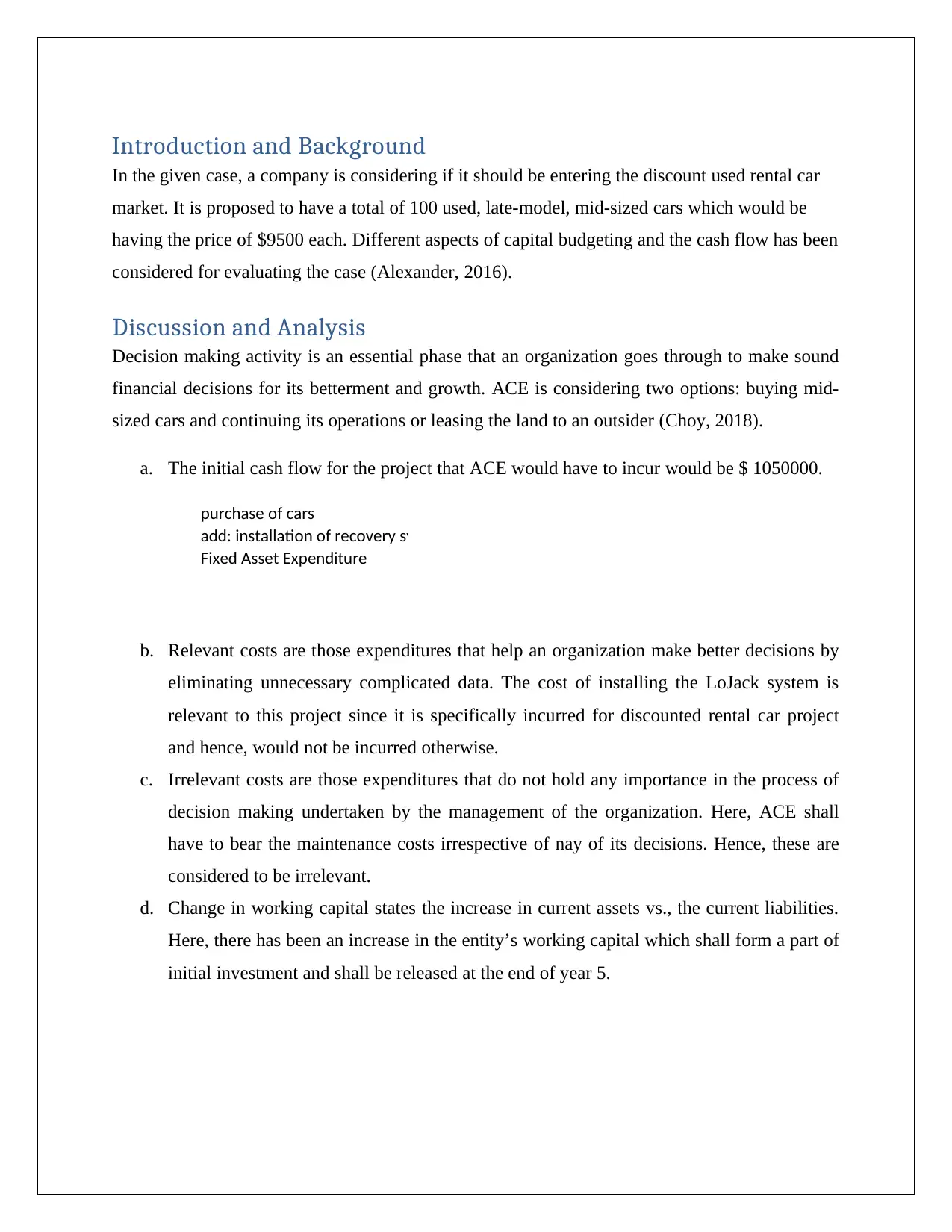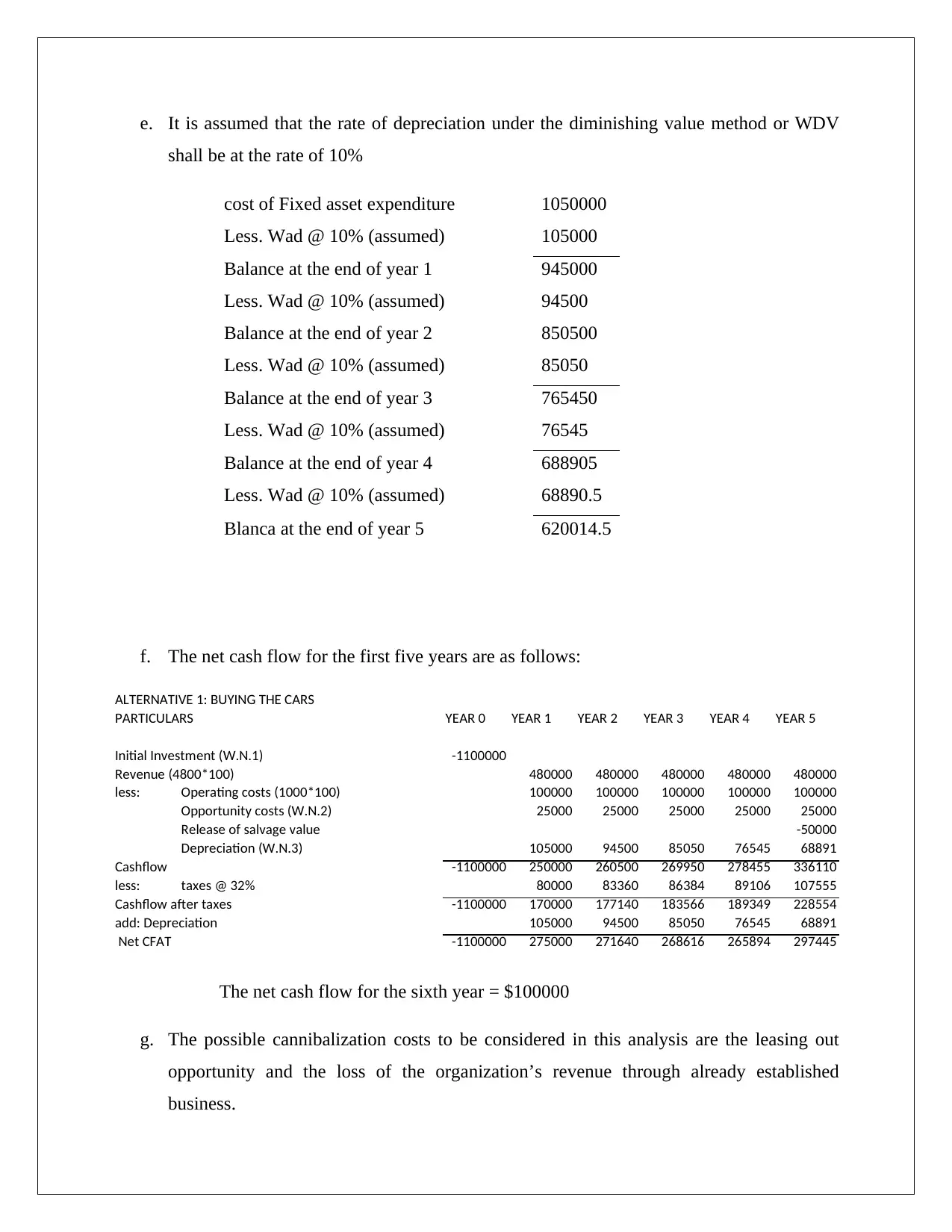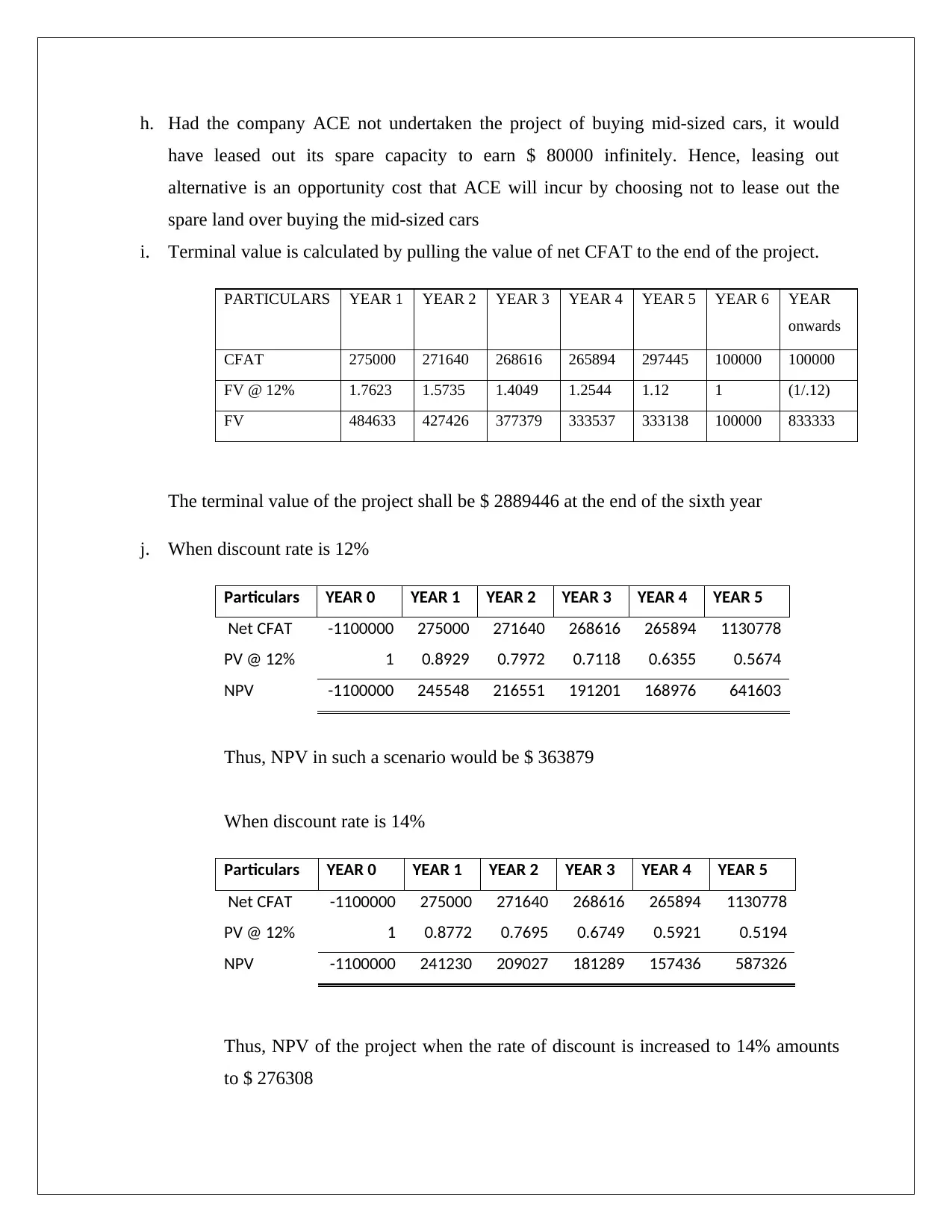BAP53 Corporate Finance: Discount Rental Car Project Analysis
VerifiedAdded on 2023/04/21
|6
|964
|60
Project
AI Summary
This assignment analyzes a corporate finance case study where Aus Car Exes (ACE) considers entering the discount used rental car market. The analysis includes the evaluation of initial cash flow, relevant and irrelevant costs, depreciation calculations using the diminishing value method, and net cash flow for five years. The assignment also addresses opportunity costs, terminal value calculations, and the impact of different discount rates (12% and 14%) on the project's net present value (NPV). The solution assesses the financial viability of the project, considering factors such as the purchase of cars, installation of recovery systems, revenue projections, operating costs, and tax implications. The assignment concludes with a comparison of NPV under different discount rates, providing insights into the project's potential profitability and financial decision-making.

BAP53- CORPORATE FINANCE
Paraphrase This Document
Need a fresh take? Get an instant paraphrase of this document with our AI Paraphraser

Table of Contents
Introduction and Background......................................................................................................................3
Discussion and Analysis...............................................................................................................................3
Introduction and Background......................................................................................................................3
Discussion and Analysis...............................................................................................................................3

Introduction and Background
In the given case, a company is considering if it should be entering the discount used rental car
market. It is proposed to have a total of 100 used, late-model, mid-sized cars which would be
having the price of $9500 each. Different aspects of capital budgeting and the cash flow has been
considered for evaluating the case (Alexander, 2016).
Discussion and Analysis
Decision making activity is an essential phase that an organization goes through to make sound
financial decisions for its betterment and growth. ACE is considering two options: buying mid-
sized cars and continuing its operations or leasing the land to an outsider (Choy, 2018).
a. The initial cash flow for the project that ACE would have to incur would be $ 1050000.
purchase of cars 950000
add: installation of recovery systems 100000
Fixed Asset Expenditure 1050000
b. Relevant costs are those expenditures that help an organization make better decisions by
eliminating unnecessary complicated data. The cost of installing the LoJack system is
relevant to this project since it is specifically incurred for discounted rental car project
and hence, would not be incurred otherwise.
c. Irrelevant costs are those expenditures that do not hold any importance in the process of
decision making undertaken by the management of the organization. Here, ACE shall
have to bear the maintenance costs irrespective of nay of its decisions. Hence, these are
considered to be irrelevant.
d. Change in working capital states the increase in current assets vs., the current liabilities.
Here, there has been an increase in the entity’s working capital which shall form a part of
initial investment and shall be released at the end of year 5.
In the given case, a company is considering if it should be entering the discount used rental car
market. It is proposed to have a total of 100 used, late-model, mid-sized cars which would be
having the price of $9500 each. Different aspects of capital budgeting and the cash flow has been
considered for evaluating the case (Alexander, 2016).
Discussion and Analysis
Decision making activity is an essential phase that an organization goes through to make sound
financial decisions for its betterment and growth. ACE is considering two options: buying mid-
sized cars and continuing its operations or leasing the land to an outsider (Choy, 2018).
a. The initial cash flow for the project that ACE would have to incur would be $ 1050000.
purchase of cars 950000
add: installation of recovery systems 100000
Fixed Asset Expenditure 1050000
b. Relevant costs are those expenditures that help an organization make better decisions by
eliminating unnecessary complicated data. The cost of installing the LoJack system is
relevant to this project since it is specifically incurred for discounted rental car project
and hence, would not be incurred otherwise.
c. Irrelevant costs are those expenditures that do not hold any importance in the process of
decision making undertaken by the management of the organization. Here, ACE shall
have to bear the maintenance costs irrespective of nay of its decisions. Hence, these are
considered to be irrelevant.
d. Change in working capital states the increase in current assets vs., the current liabilities.
Here, there has been an increase in the entity’s working capital which shall form a part of
initial investment and shall be released at the end of year 5.
⊘ This is a preview!⊘
Do you want full access?
Subscribe today to unlock all pages.

Trusted by 1+ million students worldwide

e. It is assumed that the rate of depreciation under the diminishing value method or WDV
shall be at the rate of 10%
cost of Fixed asset expenditure 1050000
Less. Wad @ 10% (assumed) 105000
Balance at the end of year 1 945000
Less. Wad @ 10% (assumed) 94500
Balance at the end of year 2 850500
Less. Wad @ 10% (assumed) 85050
Balance at the end of year 3 765450
Less. Wad @ 10% (assumed) 76545
Balance at the end of year 4 688905
Less. Wad @ 10% (assumed) 68890.5
Blanca at the end of year 5 620014.5
f. The net cash flow for the first five years are as follows:
ALTERNATIVE 1: BUYING THE CARS
PARTICULARS YEAR 0 YEAR 1 YEAR 2 YEAR 3 YEAR 4 YEAR 5
Initial Investment (W.N.1) -1100000
Revenue (4800*100) 480000 480000 480000 480000 480000
less: Operating costs (1000*100) 100000 100000 100000 100000 100000
Opportunity costs (W.N.2) 25000 25000 25000 25000 25000
Release of salvage value -50000
Depreciation (W.N.3) 105000 94500 85050 76545 68891
Cashflow -1100000 250000 260500 269950 278455 336110
less: taxes @ 32% 80000 83360 86384 89106 107555
Cashflow after taxes -1100000 170000 177140 183566 189349 228554
add: Depreciation 105000 94500 85050 76545 68891
Net CFAT -1100000 275000 271640 268616 265894 297445
The net cash flow for the sixth year = $100000
g. The possible cannibalization costs to be considered in this analysis are the leasing out
opportunity and the loss of the organization’s revenue through already established
business.
shall be at the rate of 10%
cost of Fixed asset expenditure 1050000
Less. Wad @ 10% (assumed) 105000
Balance at the end of year 1 945000
Less. Wad @ 10% (assumed) 94500
Balance at the end of year 2 850500
Less. Wad @ 10% (assumed) 85050
Balance at the end of year 3 765450
Less. Wad @ 10% (assumed) 76545
Balance at the end of year 4 688905
Less. Wad @ 10% (assumed) 68890.5
Blanca at the end of year 5 620014.5
f. The net cash flow for the first five years are as follows:
ALTERNATIVE 1: BUYING THE CARS
PARTICULARS YEAR 0 YEAR 1 YEAR 2 YEAR 3 YEAR 4 YEAR 5
Initial Investment (W.N.1) -1100000
Revenue (4800*100) 480000 480000 480000 480000 480000
less: Operating costs (1000*100) 100000 100000 100000 100000 100000
Opportunity costs (W.N.2) 25000 25000 25000 25000 25000
Release of salvage value -50000
Depreciation (W.N.3) 105000 94500 85050 76545 68891
Cashflow -1100000 250000 260500 269950 278455 336110
less: taxes @ 32% 80000 83360 86384 89106 107555
Cashflow after taxes -1100000 170000 177140 183566 189349 228554
add: Depreciation 105000 94500 85050 76545 68891
Net CFAT -1100000 275000 271640 268616 265894 297445
The net cash flow for the sixth year = $100000
g. The possible cannibalization costs to be considered in this analysis are the leasing out
opportunity and the loss of the organization’s revenue through already established
business.
Paraphrase This Document
Need a fresh take? Get an instant paraphrase of this document with our AI Paraphraser

h. Had the company ACE not undertaken the project of buying mid-sized cars, it would
have leased out its spare capacity to earn $ 80000 infinitely. Hence, leasing out
alternative is an opportunity cost that ACE will incur by choosing not to lease out the
spare land over buying the mid-sized cars
i. Terminal value is calculated by pulling the value of net CFAT to the end of the project.
PARTICULARS YEAR 1 YEAR 2 YEAR 3 YEAR 4 YEAR 5 YEAR 6 YEAR
onwards
CFAT 275000 271640 268616 265894 297445 100000 100000
FV @ 12% 1.7623 1.5735 1.4049 1.2544 1.12 1 (1/.12)
FV 484633 427426 377379 333537 333138 100000 833333
The terminal value of the project shall be $ 2889446 at the end of the sixth year
j. When discount rate is 12%
Particulars YEAR 0 YEAR 1 YEAR 2 YEAR 3 YEAR 4 YEAR 5
Net CFAT -1100000 275000 271640 268616 265894 1130778
PV @ 12% 1 0.8929 0.7972 0.7118 0.6355 0.5674
NPV -1100000 245548 216551 191201 168976 641603
Thus, NPV in such a scenario would be $ 363879
When discount rate is 14%
Particulars YEAR 0 YEAR 1 YEAR 2 YEAR 3 YEAR 4 YEAR 5
Net CFAT -1100000 275000 271640 268616 265894 1130778
PV @ 12% 1 0.8772 0.7695 0.6749 0.5921 0.5194
NPV -1100000 241230 209027 181289 157436 587326
Thus, NPV of the project when the rate of discount is increased to 14% amounts
to $ 276308
have leased out its spare capacity to earn $ 80000 infinitely. Hence, leasing out
alternative is an opportunity cost that ACE will incur by choosing not to lease out the
spare land over buying the mid-sized cars
i. Terminal value is calculated by pulling the value of net CFAT to the end of the project.
PARTICULARS YEAR 1 YEAR 2 YEAR 3 YEAR 4 YEAR 5 YEAR 6 YEAR
onwards
CFAT 275000 271640 268616 265894 297445 100000 100000
FV @ 12% 1.7623 1.5735 1.4049 1.2544 1.12 1 (1/.12)
FV 484633 427426 377379 333537 333138 100000 833333
The terminal value of the project shall be $ 2889446 at the end of the sixth year
j. When discount rate is 12%
Particulars YEAR 0 YEAR 1 YEAR 2 YEAR 3 YEAR 4 YEAR 5
Net CFAT -1100000 275000 271640 268616 265894 1130778
PV @ 12% 1 0.8929 0.7972 0.7118 0.6355 0.5674
NPV -1100000 245548 216551 191201 168976 641603
Thus, NPV in such a scenario would be $ 363879
When discount rate is 14%
Particulars YEAR 0 YEAR 1 YEAR 2 YEAR 3 YEAR 4 YEAR 5
Net CFAT -1100000 275000 271640 268616 265894 1130778
PV @ 12% 1 0.8772 0.7695 0.6749 0.5921 0.5194
NPV -1100000 241230 209027 181289 157436 587326
Thus, NPV of the project when the rate of discount is increased to 14% amounts
to $ 276308

Therefore, it can be analyzed that the project would yield better results had the
discount rate been at the reduced level of 12%.
References
Alexander, F. (2016). The Changing Face of Accountability. The Journal of Higher Education, 71(4), 411-
431.
Choy, Y. K. (2018). Cost-benefit Analysis, Values, Wellbeing and Ethics: An Indigenous Worldview
Analysis. Ecological Economics, 2(1), 145. Retrieved from
https://doi.org/10.1016/j.ecolecon.2017.08.005
discount rate been at the reduced level of 12%.
References
Alexander, F. (2016). The Changing Face of Accountability. The Journal of Higher Education, 71(4), 411-
431.
Choy, Y. K. (2018). Cost-benefit Analysis, Values, Wellbeing and Ethics: An Indigenous Worldview
Analysis. Ecological Economics, 2(1), 145. Retrieved from
https://doi.org/10.1016/j.ecolecon.2017.08.005
⊘ This is a preview!⊘
Do you want full access?
Subscribe today to unlock all pages.

Trusted by 1+ million students worldwide
1 out of 6
Your All-in-One AI-Powered Toolkit for Academic Success.
+13062052269
info@desklib.com
Available 24*7 on WhatsApp / Email
![[object Object]](/_next/static/media/star-bottom.7253800d.svg)
Unlock your academic potential
Copyright © 2020–2026 A2Z Services. All Rights Reserved. Developed and managed by ZUCOL.